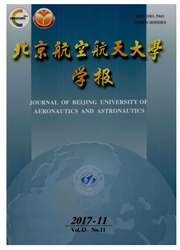

 中文摘要:
中文摘要:
针对当前轨迹线性化控制(TLC)方法对系统中的不确定性存在鲁棒性不足的问题,受非线性跟踪微分器设计思路的启发,提出了一种基于微分器设计原则的轨迹线性化控制方法.首先,引入二阶线性微分器(SOLD)的概念,通过理论分析指出了当前轨迹线性化控制方法中采用一阶惯性+伪微分器求取标称指令的微分信号时,会存在与二阶线性微分器类似的峰值现象,随后利用韩式跟踪微分器(TD)求取标称指令及其微分信号,避免了该现象的同时又赋予了系统在控制量的约束范围内调节响应快慢的能力;其次,通过构造期望的闭环系统,跟踪误差动态,直接获取线性时变(LTV)系统的控制量,使得参数整定不再依赖于并行微分(PD)谱理论,在此基础上,将混合微分器(HD)的非摄动形式等价为期望的闭环系统跟踪误差动态,以提升轨迹线性化控制方法的鲁棒性,同时借助Lyapunov稳定性理论证明了受扰系统的跟踪误差最终一致有界;最后,利用所提出的轨迹线性化控制方法设计了高超声速飞行器的姿控系统并进行了相应的仿真.结果表明:存在大范围气动参数摄动的情况下,本方法仍具有较好的控制性能及抗干扰能力,能够满足高超声速飞行器快时变、高精度以及强鲁棒的控制需求.
 英文摘要:
英文摘要:
Considering the lack of enough robustness against uncertainties in conventional trajectory linearization control (TLC) method, an improved robust control method was proposed, based on the design principle of nonlinear differentiators. Firstly, via introducing the concept of second-order linear differentiator (SOLD) , it was indicated that peaking phenomenon which was similar with using high-gains in SOLD would emerge during the transient profile of differentiation of the nominal command in the existing TLC. And then, tracking differentiator (TD) was used to produce the nominal command and its derivative, peaking phenome- non was totally eliminated and the ability of adjusting the response speed of closed-loop system under the physical limitations was endowed simultaneously. Secondly, by constructing the desired tracking error dynamics of closed-loop system, the control law of the linear time-varying (LTV) system could be directly obtained, PDspectrum theorem and real time tuning of the time varying bandwidth (TVB) of TLC were both avoided. Meanwhile, by utilizing the non-perturbation form of hybrid differentiator (HD) as the desired error dynamics of closed-loop system, the robustness of the system was thus enhanced. In addition, the boundedness of the tracking error in interference system was proved by Lyapunov theory. Finally, the proposed method was applied to the attitude tracking problem of hypersonic vehicle. The simulation results demonstrate the proposed method can still exhibit better control performance and anti-interference capability even if there exist large uncertainties in the aerodynamic parameters, thus the effectiveness and robustness of the control scheme is validated.
 同期刊论文项目
同期刊论文项目
 同项目期刊论文
同项目期刊论文
 Real-time path planning of unmanned aerial vehicle for target tracking and obstacle avoidance in com
Real-time path planning of unmanned aerial vehicle for target tracking and obstacle avoidance in com Sliding mode based trajectory linearization control for hypersonic reentry vehicle via extended dist
Sliding mode based trajectory linearization control for hypersonic reentry vehicle via extended dist A novel robust hybrid gravitational search algorithm for reusable launch vehicle approach and landin
A novel robust hybrid gravitational search algorithm for reusable launch vehicle approach and landin A novel hybrid backtracking search optimization algorithm for nonlinear optimal control problems wit
A novel hybrid backtracking search optimization algorithm for nonlinear optimal control problems wit Three-dimensional path planning for unmanned aerial vehicle based on interfered fluid dynamical syst
Three-dimensional path planning for unmanned aerial vehicle based on interfered fluid dynamical syst Trajectory Linearization control based output tracking method for nonlinear uncertain system using l
Trajectory Linearization control based output tracking method for nonlinear uncertain system using l 期刊信息
期刊信息
